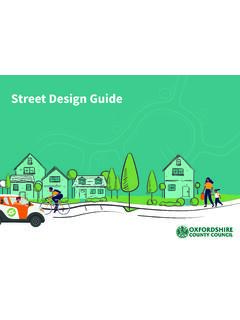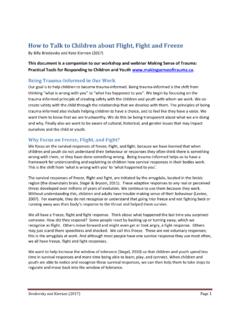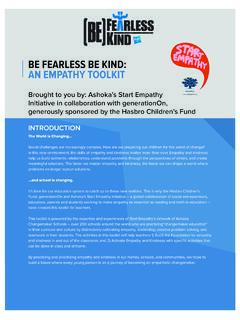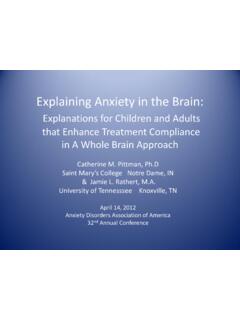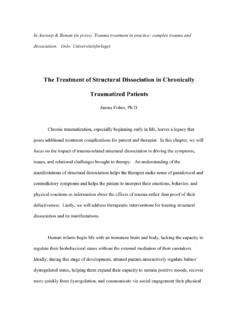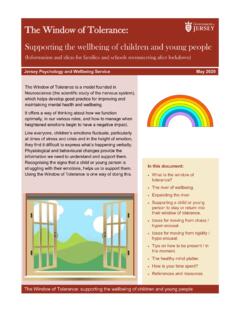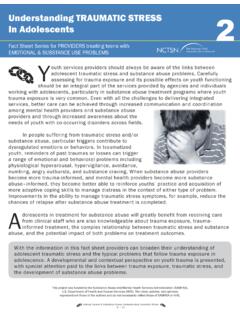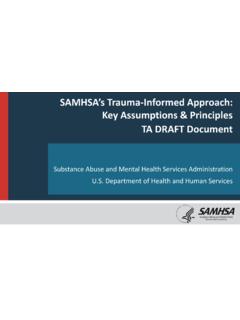Transcription of Using PACE in School - Oxfordshire County Council elections
1 Using PACE IN School Through PACE, and as they begin to feel safer, children discover they can now do better Dr Hester Riviere, Educational Psychologist Dr Rachel Evered, Clinical Psychologist Using PACE in School This leaflet is designed to help you to have effective, empowering interactions with children who have experienced trauma and who, as a result, do not respond to you in the same way as other children you teach. children who have had a difficult start to life have often learned that the world is not a safe place and that people in it cannot be trusted to help them to stay safe. Without safety and security children cannot settle to learn and explore. Many also do not think that they deserve care and attention, and many feel deeply ashamed much of the time. These feelings and assumptions about the world underpin all the interactions they have with you and their peers.
2 Working with children who do not feel safe at School is demanding and asks a lot of you as a professional. We hope that this leaflet will give you some more information about why you are successful when you are successful, why things sometimes go wrong, and some ideas for helping hard-to-reach children be settled and able to learn in your class. Understanding how feelings direct actions The work of neuropsychologist Stephen Porges has helped us to understand what happens to us all when we perceive danger. His polyvagal theory suggests a hierarchy of three levels: When we do not feel safe, the body prepares itself to respond to danger. If the danger seems very great, the nervous system is activated in such a way that we have a very high tolerance for pain, and often become very still. In this freeze state, which is the state of greatest stress, children sometimes appear to zone out , show confusing behaviours such as laughing inappropriately as though they cannot stop, or even appear to fall asleep.
3 Sometimes this is called dissociation . When we perceive threat that is not at the highest level the body prepares itself for defence. Sometimes we call this fight or flight . It is likely that you have seen this response on many occasions. children who have experienced trauma escalate into this state very quickly. It may look as though there was no trigger, or that the apparent trigger was very small. Many children who have experienced trauma are vulnerable to experiencing fight , fright or flight reactions in everyday situations which would not normally make children feel afraid. This reaction is not conscious, is completely involuntary and out of their control. In order for children to be ready to learn, however, they need to be in the calm, open and engaged state described in the graphic above. Only in this state can they engage with you and others to think about what has happened and how you can understand it together.
4 When a child is challenging or threatening to you, when you feel deskilled or frustrated by the child, your own defences are likely to kick in. At this point it is very difficult for you to be in a calm, open and engaged state too. Many teachers are more likely at this point to revert to more traditional behaviour management styles which, unfortunately, do not work with children who have experienced trauma. Very often this is the point at which communication breaks down between you and the child and the situation escalates. What does work? The experience of safety seems to have a profound effect on pupils Louise Bomber, 2013 PACE is an approach developed by Dr Dan Hughes, an American psychologist who works with traumatised children . PACE stands for Playfulness, Acceptance, Curiosity and Empathy. These principles help to promote the experience of safety in your interactions with young people.
5 children need to feel that you have connected with the emotional part of their brain before they can engage the thoughtful, articulate, problem solving areas. Connect and redirect: When a child is upset, connect first emotionally, right-brain to right-brain. Then, once the child is more in control and receptive, bring in the left-brain lessons and discipline. The Whole Brain Child, Daniel J. Siegel and Tina Payne Bryson Once a child feels that you have connected with their level of emotion, they can stop showing you. children show you how they feel through their behaviour, often in ways that are very unhelpful to you and also to themselves. Playfulness The purpose of playfulness is to enjoy being together in an unconditional way. This gives the message that the relationship is stronger than things that go wrong. Using a playful and light-hearted tone, as if you were telling a story, shows your interest and curiosity. Playfulness reduces the shame a child might feel when something has gone wrong; difficult messages or serious conversations can be easier to have if the tone is light.
6 It does not mean you do not take the emotions or the incident seriously. It is also helpful to maintain a playful tone if you need to deliver a short reminder about behaviour in the classroom. Acceptance Unconditional acceptance is fundamental to a child s sense of safety because it shows that you have connected with their feelings without judgement, and without seeking to reassure their feelings away. This can be hard to do as it means you and the child sitting with some strong emotions, together. This is painful and uncomfortable, but also very powerful. If a child expresses distressing emotions about themselves or others ( nobody loves me , I m stupid , I m bad , you hate me ) it is hard not to challenge them as being wrong, but it is really important to accept those feelings and acknowledge them Using curiosity and empathy. Accepting the child or young person s feelings and emotions does not mean accepting unwanted behaviour and it does not mean agreeing with the child s viewpoint, but for true acceptance to take place, it is important that the child also knows you can see them beyond their behaviour.
7 When a child is very challenging, on a daily basis, this can be hard to do. Try to build in times with colleagues in which you can reflect on the child beyond their behaviour as well as expressing your own feelings about the challenges. Curiosity It s important to be curious about the child s thoughts, feelings, wishes and intentions: they may still be learning that other people can think about them in this way or that they can be held in mind by an adult without judgement and accusation at all. Curiosity is also important for discipline to be effective: connect with the emotion before you engage in discussion. Showing the child that you are interested in what is going on for them and willing to do something about it is a very powerful experience. Don t feel afraid to share your curiosity with the child by wondering, not telling them.
8 Try to avoid asking Why? . Instead you might ask: Is it ok if I share my idea of what is going on for you? I might be wrong but these are my ideas. or What do you think was going on? , What do you think that was about? or I wonder Try to be curious in a quiet, accepting tone that conveys a simple desire to understand the child: this is not the same as agreeing with their perception of the event, but shows your interest in understanding it and accepting the feelings that were involved. Empathy When you show empathy you are showing the child that their feelings are important to you, and that you are alongside them in their difficulty. You are showing that you can cope with the hard times with them and you are trying hard to understand how it feels. Understanding and expressing your own feelings about the child s experience can often be more effective than reassurance. For example, if a child says You don t care , you can respond by saying That must be really hard for you.
9 I feel sad that you experience me as not caring Acceptance and empathy are your Emotional A&E. They are at the heart of the child starting to feel safe at School , which reduces conflict, stress and withdrawal. Practical Examples We have developed some scenarios of situations that frequently occur in schools. These PACE-informed scripts show how to have conversations with young people which connect with their feelings, thoughts and intentions. We hope you will find that connecting with children in this way de-escalates situations more quickly and increases trust between you and the child. Angry and Negative Statements When children make negative statements about themselves or you, for example: You re angry and you don t want me in your classroom It is tempting at this point to reply with a practical response, which may or may not be true: I m not angry and of course I want you to be here.
10 The PACE alternative would go something like this: I can see that it feels like I am really cross with you, that is a really difficult feeling to have. I wonder if that is really scary and that you feel you would be better off outside the classroom. Although it doesn t feel like it, I do really want you in my classroom. If this is too much to say to a child who is at that moment very distressed, use the Emotional A&E response: It is really hard to feel that I am cross with you, that is such a scary feeling. When a child runs away This is a difficult and frightening situation for all concerned: some situations in School are highly emotional and feel unsafe for everyone. It is important that adults make sure they manage their own strong emotions with support from others. These feelings are important to acknowledge, but it is not for the child to take responsibility for the adults feelings.




